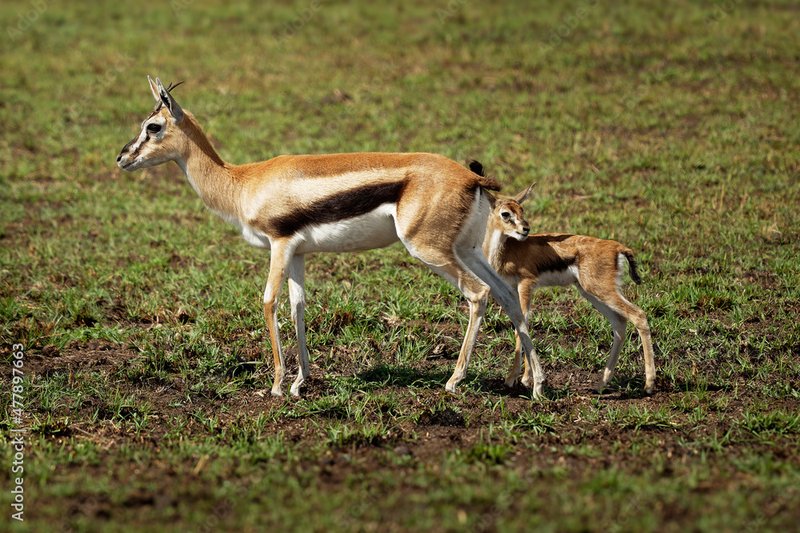
Here’s the thing: gazelles aren’t just pretty faces. These animals are complex, with unique adaptations that help them survive in their environments. However, misconceptions about their behavior, habitat, and social dynamics can paint a misleading picture. In this article, we’ll dive into some of the most common myths about gazelles, separating facts from fiction, so you can appreciate these stunning animals more fully.
Myth 1: Gazelles Are Just Fast Animals
It’s easy to assume that gazelles are simply built for speed, and while it’s true they’re incredibly fast, there’s so much more going on beneath the surface. Gazelles can run at speeds of up to 60 miles per hour, making them one of the fastest animals on land. But speed alone isn’t what keeps them alive in the wild.
The truth is, gazelles have evolved exceptional senses and strategies for survival. For instance, their wide-set eyes allow them to see nearly 360 degrees around them. This keen eyesight helps them spot predators long before they get too close.
Additionally, gazelles often use their speed in combination with sharp turning abilities. Rather than just running away in a straight line, they can zigzag quickly, making it harder for predators like cheetahs and lions to catch them. So while speed is a critical trait, it’s the combination of speed, agility, and awareness that truly defines these animals.
Myth 2: Gazelles Live in Large Herds
You might picture gazelles in vast, sprawling herds, similar to wildebeests or zebras. While some gazelle species do gather in groups, many are actually quite solitary or form smaller family units. For example, a species like the Thomson’s gazelle tends to live in groups that can range from just a few individuals to several dozen.
Here’s an interesting twist, too: the size of the group can vary depending on environmental factors. During dry seasons, when food is scarce, gazelles may spread out to find resources. In contrast, during wetter seasons, you might see them coming together in larger numbers. This flexibility in social behavior is a survival strategy, showcasing how these animals adapt to their surroundings.
Myth 3: All Gazelles Are Identical
At first glance, gazelles may seem similar, but there are different species with unique traits and behaviors. For instance, the Grant’s gazelle is different in size and has distinct markings compared to the Dama gazelle, which is critically endangered.
Each species has adapted to its specific habitat and lifestyle. For example, Dama gazelles prefer forested and scrubby areas, while Thomson’s gazelles thrive on the open plains, where they can easily spot predators.
Understanding these differences helps us appreciate how diverse this family of animals really is. So, the next time you see a gazelle, remember that it’s not just a single type of animal, but a whole group of unique creatures, each with its own story.
Myth 4: Gazelles Are Always on the Move
It’s easy to think of gazelles as constantly sprinting across the savanna. While they are known for their speed, they also have periods of rest and relaxation. Gazelles often lounge around during the hottest parts of the day, seeking shade under trees or bushes to stay cool and conserve energy.
During these downtime moments, gazelles groom themselves or simply enjoy the peace of their surroundings. This behavior is crucial for maintaining their health. *Picture this*: after a long sprint to evade a predator, they need to recuperate, just like any athlete.
In addition, their sleeping habits revolve around their need to be alert. They often sleep in a position that allows them to quickly get up and flee if necessary. That means they balance activity with rest for optimal survival.
Myth 5: Gazelles Are Not Social Animals
While gazelles may not exhibit the same complex social structures as elephants or primates, they definitely have social behaviors that are worth noting. Gazelles often communicate with each other through various vocalizations and physical gestures. They use barks, snorts, or even body language to signal danger or call for their friends.
Interestingly, some gazelle species engage in cooperative behavior. For instance, when one gazelle senses a predator, it might alert the others, creating a ripple effect throughout the group. This form of communication can be crucial in ensuring everyone’s safety.
You might be wondering how they maintain bonds, right? Some mother gazelles will allow their young to play together, forming early social connections, which can help them learn vital survival skills. So, while they may not fit our traditional view of social animals, gazelles definitely have their own ways of connecting.
Myth 6: Gazelles Are Easy Prey
It’s a common belief that the life of a gazelle revolves around being hunted. While it’s true that gazelles face threats from predators, they aren’t just sitting ducks in the wild. Their speed, agility, and heightened senses provide them with many defenses.
Gazelles often display a behavior called the “stotting,” where they leap high into the air when they see a predator. This behavior serves a dual purpose: it shows off their fitness and can often confuse or deter predators, making them think twice about the chase.
Also, their habitats often provide natural cover where they can quickly hide. In this way, gazelles are not merely victims but clever survivors in a challenging environment.
So, where does that leave us in our understanding of these fascinating creatures? Gazelles are much more than just fast, beautiful animals. They’re complex, adaptable, and full of surprises. By debunking these common myths and misconceptions, we can gain a deeper appreciation for their role in the ecosystem and their fascinating behaviors.
Whether you’re watching them on a documentary or hoping to spot one on your next safari, remember: the world of gazelles is full of wonder and intrigue. Understanding them better enriches our connection to the animal kingdom and sparks curiosity about the many creatures we share our planet with. Keep exploring, asking questions, and uncovering the truth behind the myths!

